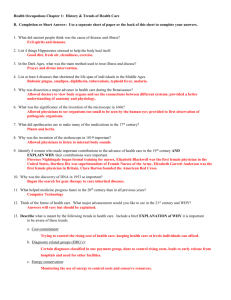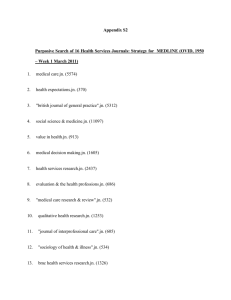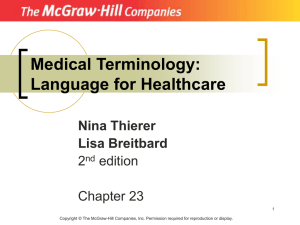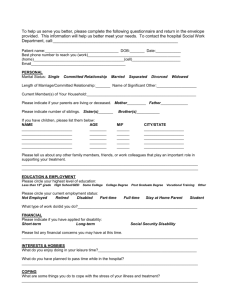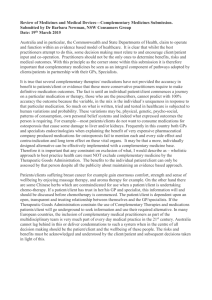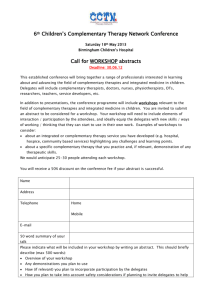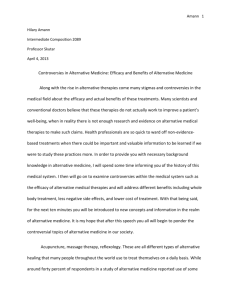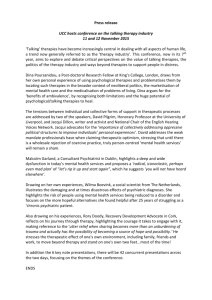Syllabus (2007)
advertisement
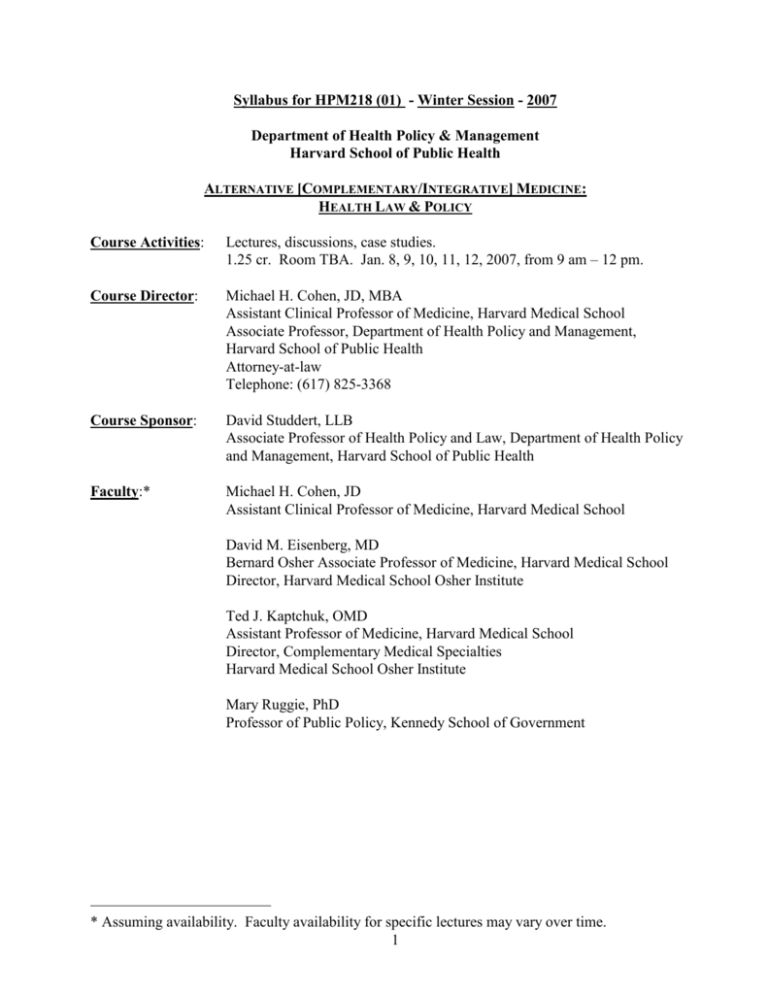
Syllabus for HPM218 (01) - Winter Session - 2007 Department of Health Policy & Management Harvard School of Public Health ALTERNATIVE [COMPLEMENTARY/INTEGRATIVE] MEDICINE: HEALTH LAW & POLICY Course Activities: Lectures, discussions, case studies. 1.25 cr. Room TBA. Jan. 8, 9, 10, 11, 12, 2007, from 9 am – 12 pm. Course Director: Michael H. Cohen, JD, MBA Assistant Clinical Professor of Medicine, Harvard Medical School Associate Professor, Department of Health Policy and Management, Harvard School of Public Health Attorney-at-law Telephone: (617) 825-3368 Course Sponsor: David Studdert, LLB Associate Professor of Health Policy and Law, Department of Health Policy and Management, Harvard School of Public Health Faculty:* Michael H. Cohen, JD Assistant Clinical Professor of Medicine, Harvard Medical School David M. Eisenberg, MD Bernard Osher Associate Professor of Medicine, Harvard Medical School Director, Harvard Medical School Osher Institute Ted J. Kaptchuk, OMD Assistant Professor of Medicine, Harvard Medical School Director, Complementary Medical Specialties Harvard Medical School Osher Institute Mary Ruggie, PhD Professor of Public Policy, Kennedy School of Government * Assuming availability. Faculty availability for specific lectures may vary over time. 1 Course Objectives: By the end of the course, students should be able to: 1. Understand of major controversies in health law and policy surrounding the proposed (judicious) integration into mainstream health care of modalities that have historically been outside of biomedicine, and are generally known as “complementary and alternative medical” (CAM) therapies (e.g., therapies as chiropractic, acupuncture, massage therapy, and herbal medicine). 2. Understand attempts by legislatures and courts to solve major legal, regulatory and policy issues confronting clinicians and institutions seeking to conscientiously advise patients concerning use of CAM therapies. 3. Analyze at least one contemporary public health and policy issues concerning integration of CAM therapies in depth, proposing possible solutions. Outcome Measures Class Participation Active learning through class participation and discussion are an important component of the course. Students are expected to attend and participate in all classes. Written Assignments See Course Requirements, below. Course Requirements: (1) Regular attendance and thoughtful participation in the discussions. (2) For most seminar sessions, several readings will be required. Please try to stay ahead in the reading, as all the topics are inter-related and in some classes we may wish to include discussion of future topics on the syllabus. The major texts are the books; they should be pleasurable to read as well as informative. Please do not be overwhelmed by the Supplemental Readings; these are included largely as background or resources for more information, compiled in order to: (a) stimulate thinking about potential research projects, and (b) give a jump-start on the research for the student papers. The Supplemental Readings are, in the main, suggested but not required. (3) One 8-10 page paper with a 15-minute class presentation, on a subject (to be approved by the course director) relevant to course material. Please note that due to the short time frame for the course it will be useful to start on the paper and presentation right away. Students receiving the syllabus prior to the course can also begin reading the materials and thinking about paper topics. Grading criteria: Grades are based on the strength of the paper and the presentation together. Grades will be awarded according to the standard HSPH index. 2 Course Description: This course introduces students to controversies in health law and policy surrounding the proposed (judicious) integration into mainstream health care of modalities that have historically been outside of biomedicine, and are generally known as “complementary and alternative medical” (CAM) therapies (e.g., therapies as chiropractic, acupuncture, massage therapy, and herbal medicine). “Integrative medicine,” as this is sometimes known, has been steadily moving from “marginal to mainstream,” to borrow the title of Professor Ruggie’s book, with representation in increasing numbers of hospitals and pervasive interest (as well as skepticism) among clinicians, patients, and professional health care organizations. According to the recent report by the Institute of Medicine, Complementary and Alternative Medicine (Washington, D.C.: National Academy of Sciences, 2005): “The goal should be the provision of comprehensive medical care that is based on the best scientific evidence available regarding benefits and harm, that encourages patients to share in decision making about therapeutic options, and that promotes choices in care that can include CAM therapies, when appropriate.” Topics for the course will be selected from among the following: definition and prevalence of CAM therapies; theory and practice of major CAM therapies; research methodologies, state of the science, and the role of evidence-based medicine in evaluating CAM therapies; licensing and regulation of CAM providers; professional discipline of physicians offering CAM therapies; credentialing and liability management strategies by health care institutions integrating these therapies; malpractice liability and informed consent issues; federal regulation of (and institutional policy involving) dietary supplements; emerging federal policy and state legislative developments; and related ethical questions. Readings are drawn from medical, public health, health policy, and sociological literature, as well as from statutes and cases. Students are expected to write an 8 to 10 page final paper and present a synopsis in class. No previous background in law is required, although HPM 213c and 215d are recommended. Materials: Required: 1. Michael H. Cohen, Complementary & Alternative Medicine: Legal Boundaries and Regulatory Perspectives (Baltimore: Johns Hopkins University Press, 1998). 2. Required supplemental materials (cases, statutes, articles) made available through the course website on the Complementary and Alternative Medicine Law Blog under the heading, Complementary and Alternative Medicine: Health Law & Policy 2007 (HPM 218). Highly Recommended: 1. Institute of Medicine, Complementary and Alternative Medicine (Washington, D.C.: National Academy of Sciences, 2005). 3 2. Mary Ruggie, Marginal to Mainstream (Cambridge: Cambridge University Press, 2004). 3. Additional – on the course website. We will include updates from these recommended texts and additional, current policy developments during the course discussions. Course Assignments: The course assignments are listed below. Guest speakers have been invited but are not guaranteed; if they are unable to appear, we will proceed through the assigned material on our own. Course Background: Issues of legitimization and licensure, definitions of competence, different ideologies around definitions of disease and health, and conflicts between consumer autonomy and medical decisionmaking have contributed to controversy in the ongoing discussion of selectively integrating CAM therapies into conventional clinical care. In the late-nineteenth century world of competing medical sects, scientific medicine (or biomedicine) began to dominate health care, including the regulatory environment as well as patient care. The growing power of the biomedical community resulted in increasing use of legal process and ethical rules to restrict other providers. This included expulsion of providers such as homeopaths, naturopaths, and chiropractors from medical societies, prohibition of professional association between them and medical doctors, and the passage of medical licensing laws that broadly defined the “practice of medicine” and encouraged prosecution of nonmedical providers for unlicensed medical practice. By the 1960s and 1970s, increasing patient interest in therapies such as chiropractic, naturopathy, massage therapy, acupuncture and traditional oriental medicine, nutritional and herbal medicine, folk medicine and spirituality in medicine, and mind-body therapies resulted in greater attention to “holistic health care.” This reflected a stated effort to treat illness in terms of its effect on the whole person—on physical, mental, emotional, spiritual, and environmental levels. Holistic health care styled itself as incorporating approaches outside of biomedicine, rather than relying solely on medical diagnosis and treatment. In 1992, Congress created a tiny office within the National Institutes of Health, known as the Office for Unconventional Medical Practices, to research the above practices. In 1993, an article by David M. Eisenberg, M.D. and others in the New England Journal of Medicine helped define the field for clinicians under the rubric of “alternative medicine.” The article used this term to describe therapies not commonly used in U.S. hospitals or taught in U.S. medical schools, including those listed above. In Europe, the term “complementary medicine” was gaining currency to describe these same therapies, which were much more widely accepted outside the U.S. The NIH office later was renamed the Office of Alternative Medicine and then became the National Center for Complementary and Alternative 4 Medicine (NCCAM). NCCAM presently defines CAM as covering “a broad range of healing philosophies (schools of thought), approaches, and therapies that mainstream Western (conventional) medicine does not commonly use, accept, study, understand, or make available.” In offering this definition, NCCAM observes: A few of the many CAM practices include the use of acupuncture, herbs, homeopathy, therapeutic massage, and traditional oriental medicine to promote well-being or treat health conditions. People use CAM treatments and therapies in a variety of ways. Therapies may be used alone, as an alternative to conventional therapies, or in addition to conventional, mainstream therapies, in what is referred to as a complementary or an integrative approach. Many CAM therapies are called holistic, which generally means they consider the whole person, including physical, mental, emotional, and spiritual aspects. NCCAM’s definition is neither universally accepted nor authoritative, but it does represent a starting point for thinking about what distinguishes (or fails to distinguish) CAM therapies from conventional care. State (and not federal) law controls much of CAM practice. A significant federal role, however, exists in the regulation of dietary supplements. The federal Food and Drug Administration (FDA) regulates foods, drugs, and cosmetics in interstate commerce. No new “drug” may be introduced into interstate commerce unless proven “safe” and “effective” for its intended use, as determined by FDA regulations. “Foods,” however, are subject to different regulatory requirements, and need not go through trials proving safety and efficacy. The growing phenomenon of consumer use of vitamins, minerals, herbs, and other “dietary supplements” challenged the historical divide between drugs and foods. The federal Dietary Supplements Health Education Act (“DSHEA”) has allowed manufacturers to distribute dietary supplements without having to prove safety and efficacy, so long as the manufacturers have made no claims linking the supplements to a specific disease. State law regulates use of CAM therapies through a variety of legal rules. Of these, several major areas of concern for clinicians, policymakers, and students of public health are: professional licensure and scope of practice, and malpractice. Regarding licensure, each state has enacted a medical licensing that prohibits the unlicensed practice of medicine and thereby criminalizes activity by unlicensed CAM providers who offer health care services to patients. Malpractice is defined as unskillful practice, which fails to conform to a standard of care in the profession, and results in injury. The definition is no different in CAM than in general medicine; its application to CAM, however, raises novel questions. Courts rely on medical consensus regarding the appropriateness of a given therapy. A framework for assessing potential liability risk involves assessing the medical evidence concerning safety and efficacy, and then aligning clinical decisions with liability concerns. Yet ultimately, research may or may not establish a specific CAM therapy as an important component part of the standard of care for the condition in question. Legal rules governing CAM providers and practices are, in many cases, new and evolving. Further, laws vary by state and their application depends on the specific clinical scenario in question. New research is constantly emerging, as are federal and state legislative developments and judicial 5 opinions resulting from litigation. Three significant developments are: approval of final guidelines, by the Federation of State Medical Boards, to govern physician integration of CAM therapies; a final report, issued to Congress by the White House Commission on Complementary and Alternative Medicine, making recommendations for federal legislation and policy; the 2005 report issued by the Institute of Medicine. These policy developments are likely to influence future efforts at regulating CAM therapies both at the federal level, where possible, and across states, as well as through the efforts of professional healthcare organizations. We will update our readings with discussion of current controversies surrounding these documents and other developments in the field. As more evidence accumulates regarding safety and efficacy (or lack thereof) of specific therapies for given conditions, and as legislators and judges clarify the permissible boundaries of health care practices involving CAM therapies, clinical pathways and legal rules will further evolve. Course Assignments: Since our Winter Session is so short, my recommendation for getting the most of the course is to read Complementary and Alternative Medicine: Legal Boundaries and Regulatory Perspectives (Johns Hopkins Univ. Press, 1998) in its entirety before the first day of class. Please also read the Executive Summary of the Institute of Medicine Report on Complementary and Alternative Medicine (2005). Then, read the supplemental and highly recommended materials as desired to assist with your research paper. Guest lectures scheduled: TBA. Additional topics (to be covered in varying depth by M. Cohen): - State law regulation of medicine (Cohen (1998) 1-55; various supplemental materials) Malpractice, informed consent, and liability management (Cohen 56-72; various supplemental materials) Professional discipline, fraud, reimbursement (Cohen 87-108 ; various supplemental materials) Dietary supplements (Cohen 73-86; various supplemental materials) Other issues (Cohen 109-120; various supplemental materials) Presentations of student papers and wrap-up 6 HPM 218: More Supplemental Materials Complementary and Alternative Medicine: Health Law & Policy Note: Below are additional supplemental materials that may be helpful in exploring specific topics for the paper. These readings were initially assigned and collected in a hard binder; however, these days it is much more efficient to post links on the course website, and/or leave it to students’ discretion to search online for such supplemental materials as may be helpful in diving deeper into specific topics. In addition, many of these are sources are amply canvassed in the Institute of Medicine’s Report on Complementary and Alternative Medicine (2005). Table of Contents* 1 Overview Angell M, Kassirer JP. Alternative medicine--the risks of untested and unregulated remedies. N Engl J Med 1998; 339:839-41. Astin JA. Why patients use alternative medicine: results of a national study. JAMA 1998; 279:1548-53. Delbanco T, Ivker R, Relman A, Riley D. Complementary and alternative therapies and the question of evidence [Panel Discussion]. Advances in Mind-Body Medicine 2000; 16:244-60. Eisenberg DM, Davis RB, Ettner RL, Appel S, Wilkey S, Rompay MV, & Kessler R. Trends in alternative medicine in the United States, 1990-1997: results of a follow-up national survey. 280 JAMA 1569 (1998). Eisenberg DM, Kessler RC, Van Rompay MI, et al. Perceptions about complementary therapies relative to conventional therapies among adults who use both: Results from a national survey. Ann Intern Med 2001; 135:344-351. Fontarosa PB, Lundberg GM, Alternative medicine meets science. 280 JAMA 1618 (1998). Frenkel M, Arye EB. The growing need to teach about complementary and alternative medicine: Questions and challenges. Acad Med 2001; 76:251-254. Jonas WB, Alternative medicine—learning from the past, examining the present, advancing to the future. 80 JAMA 1616 (1998). Kaptchuk TJ. Acupuncture: Theory, efficacy and practice. Ann Intern Med 2002;136:374-383. Kaptchuk TJ. Varieties of Healing 1: Medical Pluralism in the United States. 135 Ann. Int. Med. 189 (2001). * Legal citations for cases in these course materials refer to the copied material, and not to the complete case history. 7 Kaptchuk TJ. Varieties of Healing 2: A Taxonomy of Unconventional Healing Practices, 135 Ann. Int. Med. 196(2001). Kaptchuk TJ, Eisenberg DM. The persuasive appeal of alternative medicine. 129 Ann. Int. Med. 1061 (198). Larkin M. Alternative medicine centre aims for mainstream status. Lancet 2001;358:566. Lord Baldwin. Why Patients Use Alternative Medicine. 280 JAMA 1659 (1998). Schaffner KE. Assessments of Efficacy in Biomedicine: The Turn Toward Methodological Pluralism, in The Role of Complementary & Alternative Medicine: Accommodating Pluralism 114 (Daniel Callahan, ed.) (Washington, D.C.: Georgetown University Press, 2002). Straus SE. Complementary and alternative medicine: Challenges and opportunities for American medicine. Acad Med 2000; 75(6):572-573. Zollman C, Vickers A. ABC of complementary medicine: what is complementary medicine? BMJ 1999; 319:693-6. Zollman C, Vickers A. ABC of complementary medicine: users and practitioners of complementary medicine. BMJ 1999; 319:836-8. Zollman C, Vickers A. ABC of complementary medicine: complementary medicine in conventional practice. BMJ 1999; 319:901-4. 2 State law regulation of medicine (Regulation of practice; scope of practice) West Virginia v Dent, 129 U.S. 114 (1884). NY v Amber, 349 N.Y.S.2d 604 (NY S.Ct. 1973). Foster v. Georgia Board of Chiropractic Examiners, 359 S.E.2d 877 (Ga. 1987). Cohen, MH. Selected Massachusetts Statutes and Regulations Defining Chiropractic, Acupuncture, and Massage Therapy. Eisenberg DM, Cohen MH, Hrbek A, Grayzel J, van Rompay MI, Cooper, RA. Credentialing complementary and alternative medical providers. Ann Intern Med; 2002;137:965-973. 3 State law regulation of medicine (Malpractice Liability; Informed Consent) Studdert DM, Eisenberg DM, Miller FH, Curto DA, Kaptchuk TJ, Brennan TA, Medical malpractice implications of alternative medicine [see comments], 280 JAMA 1610 (1998). 8 Cohen MH, Eisenberg DM. Potential physician malpractice liability associated with complementary/integrative medical therapies. Ann Int Med; 2002;136:596-603. Ernst EE, Cohen MH. Informed consent in complementary and alternative medicine. Arch Intern Med 2001;161:19:2288-2292. Charell v Gonzalez 660 N.Y.S.2d 665 (NY S.Ct. 1997). Moore v Baker, 989 F.2d 1129 (11th Cir. 1993). Schneider v Revici, 817 F.2d 987 (2d Cir. 1987). 4 State law regulation of providers NY Educ. L. s. 6527(4)(e). Gonzales v NY State Department of Health, 648 N.Y.S.2d 827 (App. Div. 1996). Metzler v NY State Board for Professional Medical Conduct, 203 A.D.2d 617 (N.Y. App. Dept. 1994). Federation of State Medical Boards, Guidelines for Complementary and Alternative Therapies in Medical Practice (2002) (available at www.fsmb.org). Comments from Emord & Associates to Federation regarding Guidelines (2002). Pelletier KR, Astin JA, Haskell WL. Current trends in the integration and reimbursement of complementary and alternative medicine by managed care organizations (MCOs) and insurance providers: 1998 update and cohort analysis. Am J Health Promot 1999; 14(2):125-33. Pelletier KR, Marie A, Krasner M, Haskell WL. Current trends in the integration and reimbursement of complementary and alternative medicine by managed care, insurance carriers, and hospital providers. Am J Health Promot 1997; 12:112-123. 5 Federal regulation and access issues Stenson J. The promises and perils of supplements (2002). (available at http://www.msnbc.com/news/522365.asp). Dietary Supplements Health Education Act, 103 P.L. 417; 108 Stat. 4325; 1994. Executive Summary, Final Report, White House Commission on Complementary and Alternative Medicine Policy (2002). Christensen, Clayton M., Richard M.J. Bohmer, and John Kenagy, Will disruptive innovations cure health care? Harvard Business Review (September-October 2000), 102-117. 9 U.S. v. Rutherford, 442 U.S. 544 (1979). Fugh-Berman A. Herb-drug interactions. Lancet 2000; 355:134-8. Piscitelli SC, Burstein AH, Chaitt D, Alfaro RM, Falloon J. Indinavir concentrations and St. John's wort. Lancet 2000; 355:547-8. 6 Interdisciplinary/frontier perspectives Adams KE, Cohen MH, Jonsen AR, Eisenberg DM. Ethical considerations of complementary and alternative medical therapies in conventional medical settings. Ann Intern Med; 2002;137:660-664 Bausell RB, Berman BM. Commentary: Alternative medicine: Is it a reflection of the continued emergence of the biopsychosocial paradigm? Am J Med Qual 2002; 17(1):28-32. Hahn RA. Belief as pathogen, belief as medicine: "voodoo death" and the "placebo phenomenon" in anthropological perspective. Med Anthr Quart 1983; 14:3-19. Kleinman A, Sung LH. Why do indigenous practitioners successfully heal? Soc Sci Med [Med Anthropol] 1979; 13:7-26. Koenig HG. Religion, spirituality and medicine: Application to clinical practice. JAMA 2000;284(13):1708. Kaptchuk TJ, The double-blind randomized placebo-controlled trial: gold standard or golden calf? 54 J Clin Epidemiol 541 (2001). Kaptchuk TJ. Intentional ignorance: A history of blind assessment and placebo controls in medicine. Bull Hist Med 1998; 72(3):389-433. Kaptchuk TJ, The placebo effect in alternative medicine: Can the performance of a healing ritual have clinical significance? 136(11) Ann. Intern. Med. 817 (2002). Larson DB & Larson SB. Spirituality in Clinical Care: A Brief Review of Patient Desire, Physician Response, and Research Opportunities, in The Role of Complementary & Alternative Medicine: Accommodating Pluralism 84-106 (Daniel Callahan, ed.) (Washington, D.C.: Georgetown University Press, 2002). O’Connor BB, Personal Experience, Popular Epistemology, and Complementary and Alternative Medicine Research, in in The Role of Complementary & Alternative Medicine: Accommodating Pluralism 54-73 (Daniel Callahan, ed.) (Washington, D.C.: Georgetown University Press, 2002). Snyderman R, Weil AT. Integrative medicine: Bringing medicine back to its roots. Arch Intern Med 2002; 162:395-7. 10
